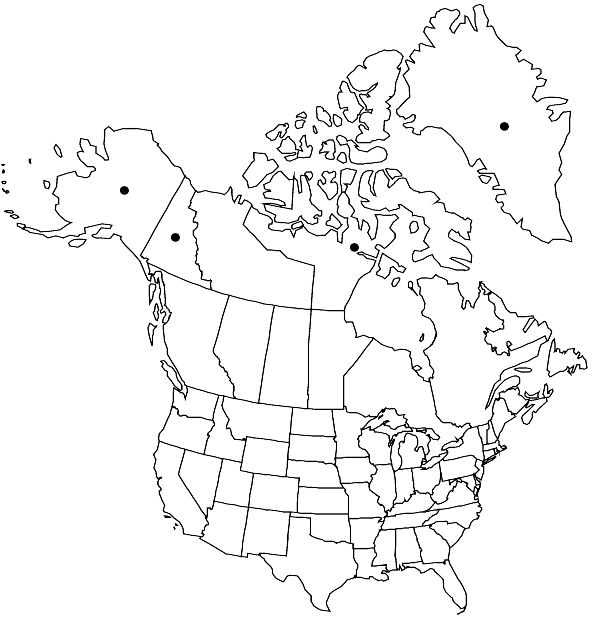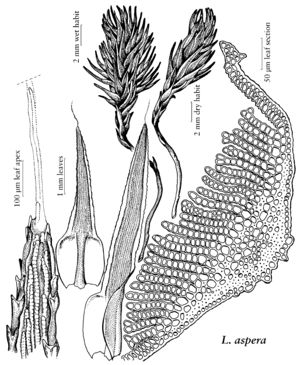Difference between revisions of "Lyellia aspera"
in A. J. Grout, Moss Fl. N. Amer. 1: 111. 1937,.
imported>Volume Importer |
imported>Volume Importer |
||
| Line 1: | Line 1: | ||
{{Treatment/ID | {{Treatment/ID | ||
|accepted_name=Lyellia aspera | |accepted_name=Lyellia aspera | ||
| − | |accepted_authority=(I. Hagen & C. E. O. Jensen) Frye | + | |accepted_authority=(I. Hagen & C. E. O. Jensen) Frye |
|publications={{Treatment/Publication | |publications={{Treatment/Publication | ||
|title=in A. J. Grout, Moss Fl. N. Amer. | |title=in A. J. Grout, Moss Fl. N. Amer. | ||
| Line 26: | Line 26: | ||
|habitat=Soil | |habitat=Soil | ||
|elevation=low to moderate elevations, typically admixed with other bryophytes | |elevation=low to moderate elevations, typically admixed with other bryophytes | ||
| − | |distribution=Greenland;Nunavut | + | |distribution=Greenland;Nunavut;Yukon;Alaska;Asia (Russia in Siberia: Taimyr Peninsula;Yakutia;Chukotka;Anadyr Basin;Wrangel Island). |
|discussion=<p>The delicate “whisker” at the leaf apex of <i>Lyellia aspera</i> (W. C. Steere 1956) is unique to this species and quite unlike the stout hair points of other Polytrichaceae. The hair is 2-seriate for much of its length, becoming 1-seriate near the tip, the longitudinal cell walls strongly thickened, and the transverse septa thin-walled. The hair is hygroscopic, twitching gently in response to changes in humidity. Sporophytes are not known for North America, for which place the species was first described. Capsules of <i>L. aspera</i> from Siberia (O. M. Afonina and E. N. Andrejeva 1993) are similar in essential features to those of L. crispa, the type of the genus, but smaller and more slender. In Nunavut, it is known from Baffin Island. The calyptra of <i>L. aspera</i> is still unknown.</p> | |discussion=<p>The delicate “whisker” at the leaf apex of <i>Lyellia aspera</i> (W. C. Steere 1956) is unique to this species and quite unlike the stout hair points of other Polytrichaceae. The hair is 2-seriate for much of its length, becoming 1-seriate near the tip, the longitudinal cell walls strongly thickened, and the transverse septa thin-walled. The hair is hygroscopic, twitching gently in response to changes in humidity. Sporophytes are not known for North America, for which place the species was first described. Capsules of <i>L. aspera</i> from Siberia (O. M. Afonina and E. N. Andrejeva 1993) are similar in essential features to those of L. crispa, the type of the genus, but smaller and more slender. In Nunavut, it is known from Baffin Island. The calyptra of <i>L. aspera</i> is still unknown.</p> | ||
|tables= | |tables= | ||
| Line 36: | Line 36: | ||
-->{{#Taxon: | -->{{#Taxon: | ||
name=Lyellia aspera | name=Lyellia aspera | ||
| − | |authority=(I. Hagen & C. E. O. Jensen) Frye | + | |authority=(I. Hagen & C. E. O. Jensen) Frye |
|rank=species | |rank=species | ||
|parent rank=genus | |parent rank=genus | ||
| Line 44: | Line 44: | ||
|habitat=Soil | |habitat=Soil | ||
|elevation=low to moderate elevations, typically admixed with other bryophytes | |elevation=low to moderate elevations, typically admixed with other bryophytes | ||
| − | |distribution=Greenland;Nunavut | + | |distribution=Greenland;Nunavut;Yukon;Alaska;Asia (Russia in Siberia: Taimyr Peninsula;Yakutia;Chukotka;Anadyr Basin;Wrangel Island). |
|reference=None | |reference=None | ||
|publication title=in A. J. Grout, Moss Fl. N. Amer. | |publication title=in A. J. Grout, Moss Fl. N. Amer. | ||
|publication year= | |publication year= | ||
|special status= | |special status= | ||
| − | |source xml=https:// | + | |source xml=https://bitbucket.org/aafc-mbb/fna-data-curation/src/2e0870ddd59836b60bcf96646a41e87ea5a5943a/coarse_grained_fna_xml/V27/V27_200.xml |
|genus=Lyellia | |genus=Lyellia | ||
|species=Lyellia aspera | |species=Lyellia aspera | ||
Latest revision as of 22:24, 5 November 2020
Plants bare and thread-like below, rather abruptly leafy above, dark green to chestnut-brown. Leaves with a narrower, lanceolate limb above the sheathing base, imbricate and crispate distally when dry, erect-spreading when moist, 7–8 mm, lamina 2-stratose, leaf tip truncate, with a single delicate, sinuous capillary hair (deciduous and often lost in older leaves); sheath pale to yellowish, not completely enclosing stem, oblong to subquadrate, entire, not hyaline-margined, with a wedge-shaped patch (hinge) of incrassate cells just above sheath; limb 0.7 mm wide at base, 4.5–5.5 mm; costa narrow, percurrent or excurrent with a few rows of teeth on abaxial surface near apex, forming discontinuous lamellae; lamina margins ± erect to broadly inflexed, entire below, 2-stratose and coarsely serrate in distal 1/3–1/2, teeth in pairs, terminal tooth cell not much larger than the others; lamina 2-stratose except for 1–2 rows of cells just inside the thickened margin, adaxial surface of lamina longitudinally grooved; lamina cells isodiametric, 7–12 µm wide, adaxial layer of cells in cross section higher than wide, turgid-mammillose, strongly bulging, moderately thick-walled; cells of abaxial layer isodiametric, ± plane, with thickened exterior walls; lamellae (18–)24–33 µm, restricted to 1/3–1/2 of leaf width, (5–)8–12(–15) cells high, in profile subentire to irregularly crenulate, marginal cells in cross-section undifferentiated or somewhat higher than wide and with a thickened apex, sporadically geminate. Sporophytes not reported within range of flora.
Habitat: Soil
Elevation: low to moderate elevations, typically admixed with other bryophytes
Distribution

Greenland, Nunavut, Yukon, Alaska, Asia (Russia in Siberia: Taimyr Peninsula, Yakutia, Chukotka, Anadyr Basin, Wrangel Island).
Discussion
The delicate “whisker” at the leaf apex of Lyellia aspera (W. C. Steere 1956) is unique to this species and quite unlike the stout hair points of other Polytrichaceae. The hair is 2-seriate for much of its length, becoming 1-seriate near the tip, the longitudinal cell walls strongly thickened, and the transverse septa thin-walled. The hair is hygroscopic, twitching gently in response to changes in humidity. Sporophytes are not known for North America, for which place the species was first described. Capsules of L. aspera from Siberia (O. M. Afonina and E. N. Andrejeva 1993) are similar in essential features to those of L. crispa, the type of the genus, but smaller and more slender. In Nunavut, it is known from Baffin Island. The calyptra of L. aspera is still unknown.
Selected References
None.
